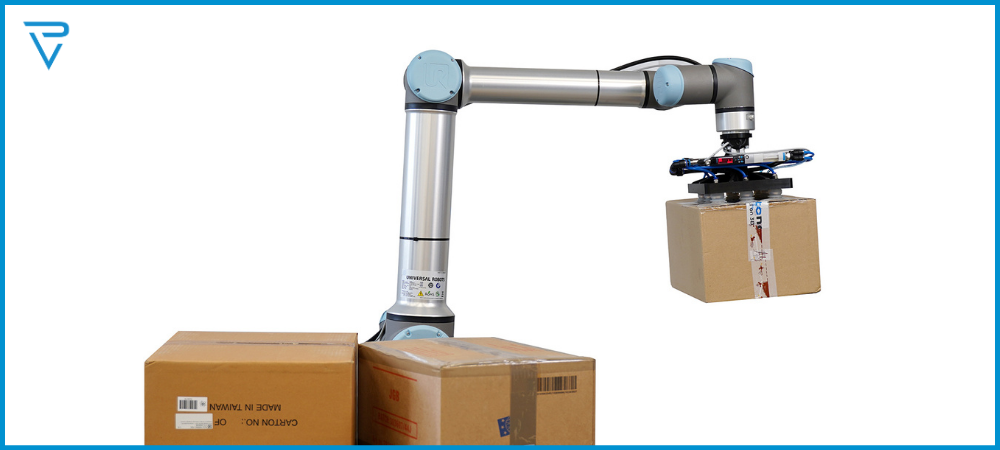
Logistics automation: Benefits and implementation
Over the past decade, logistics automation has gained significant momentum, as we can see in the way goods are managed, stored, and transported today. The use of robots, AI, and machine vision is becoming a must for logistics companies that strive to to gain and keep a competitive advantage in the sector and meet rising customer expectations.
From warehouse operations to transportation management, logistics automation brings customers many benefits. These range from increased productivity, efficiency, and accuracy to overall optimization of logistical processes.
This blog article explores the major benefits of automation, the most common applications that are being automated, as well as the most common components and solution types deployed in the logistics sector.
What is logistics automation?
Logistics automation refers to implementing technology-driven automated systems to optimize various operational processes within the logistics industry. Logistics automation incorporates the use of many different advanced technologies and software, such as artificial intelligence, machine vision, robotics, and others.
Logistics automation is allowing organizations to scale up their operations exponentially and to minimize inefficiencies and errors that usually come with manual labor. Let’s have a look at the benefits in more detail.
Benefits of logistics automation
Automation technologies enable logistics companies to handle the ever-growing volumes of goods and optimize resource utilization. Thanks to automation, logistics companies are better able to cater and adapt to consumer expectations. The major benefits include:
- Improved efficiency: Automation helps streamline logistics processes by reducing the need for manual labor, thus increasing process efficiency.
- Increased accuracy: The deployment of automation systems leaves less room for errors. Advanced technologies such as RFID tracking (based on radio-frequency identification) or barcode scanning also reduce technical mistakes.
- Better inventory management: Thanks to automation, logistics companies can better control, restock, and optimize their inventory levels and stocks. Automated systems also reduce holding costs as companies can restock shelves based on their needs.
- Opportunities for scaling up: Automated systems can support the scalability and adaptability of logistics companies to their ever-changing business needs coming as a response to the demand-supply fluctuations in the market.
- Improved safety and security: Automation helps increase safety by reducing the risk of injuries.
- Enhanced customer satisfaction: Automation enables faster order processing, live-time tracking of shipments, and timely delivery of goods. This leads to enhanced customer service and company growth.
Logistics processes suitable for automation
Logistics automation encapsulates a wide range of operations and processes. Here are some of the most common processes where logistics automation is widely deployed:
- Order processing: Including the automation of order entries, validation, and confirmation.
- Warehouse operations: Including the automation of goods receipt, picking, packing, loading, and unloading.
- Transportation of goods: Automating the transport of goods and services can result in reduced fuel consumption, enhanced route efficiency, and overall lower transportation costs.
- Inventory management: Automating inventory management allows companies to track and monitor their stocks in real-time. It also leads to efficient demand forecasting.
- Shipment tracking: With real-time monitoring and visibility of shipments, consumers and companies can check goods’ live status and location. This can lead to a proactive resolution in case any issue during shipment pops up.
- Safety and security compliance
Components of logistics automation systems
Robots
Logistics automation involves the deployment of robots, robotic arms, robot pickers, or autonomous mobile robots (AMRs). Such robots are specially designed to perform multiple tasks, such as picking, sorting, moving goods around etc.
Machine vision systems
Machine vision systems utilize cameras and image processing algorithms to capture and analyze visual information. These systems can be used in logistics automation for tasks such as object recognition, quality control and inspection, or dimensioning.
Photoneo provides state-of-the-art industrial 3D sensors that can be used in all kinds of applications – PhoXi 3D Scanners for scanning static scenes in superior quality or MotionCam-3D for scanning in motion.
Software
Automated systems heavily rely on software, as they are responsible for providing control and integration of other automated systems. Some commonly utilized software within logistics industries includes Warehouse Management Systems (WMS) or Transportation Management Systems (TMS). They are responsible for order processing, warehouse optimization, inventory management, route optimization, and transportation planning, among other functions.
Artificial intelligence
Advanced machine-learning algorithms are often used for the automation of tasks such as object recognition and identification, picking, sorting, depalletization, or delayerization.
For instance, Photoneo’s robust, AI-based neural networks are trained on thousands of objects to recognize items of any size, shape, material, color, or texture. This capability can be used for picking of mixed types of items, removing boxes and products from a pallet one by one or even by entire layers.
Conveyors
Conveyors transport items, containers, and packages within warehouses and distribution centers. Commonly used conveyors in logistics industries include belt conveyors or roller conveyors.
Because Photoneo’s 3D camera MotionCam-3D can be used for high-quality scanning in motion, it enables the recognition of items moving on a conveyor belt without stopping the movement. This saves a lot of time and increases efficiency and throughput.
Most common logistics automation solutions
There are multiple ways logistics automation can enhance customer experience by streamlining the entire logistics operations. Let’s have a look at some of these solutions:
- Automated Sorting Systems (ASS): Software, conveyors, sensors, and other cutting-edge technologies that help sort various kinds of items and efficiently handle high package volumes.
- Warehouse Management Systems (WMS): Systems that efficiently manage and control warehouse operations, such as inventory monitoring, stocks, etc.
- Transportation Management Systems (TMS): Systems that help optimize transportation routes and live-track shipments as they are on the go.
- Order Management Systems (OMS): Systems allowing companies to automate the end-to-end order processing cycle.
Conclusion
Automation helps logistics companies optimize their operations, improve productivity, and reduce technical and manual errors. Businesses can handle huge volumes of goods, which positively impacts operational costs and modern supply chain management.



